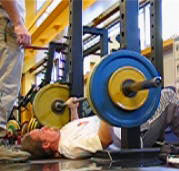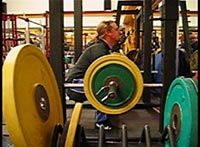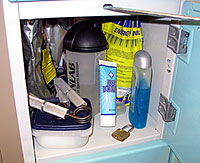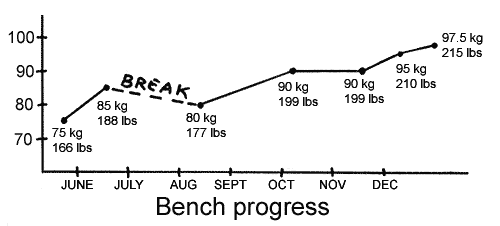Archives for workouts (page 21)
January 28, 2004
Neck benching
Much can be learned reading other people’s training logs. Or more specifically, that of OP Eskola over at Westsidebar.net (in Finnish) where he recently mentioned doing benches to the neck after his board presses. He was also kind enough to provide a clip of training partner Marko Patteri demonstrating this fab move. Basically, the bar is lowered to the collar bone with elbows held wide to the side and pressed straight up. You don’t have to be a rocket scientist to realize that this, like the Tate press and JM press, is a great movement for the lower triceps. I did it. I liked it.
What I liked less was that my back felt utterly powerless today, making the T-bar rows feel like a bee trying to get lift-off after crash landing in banana flavored chewing gum.
Speed bench; wide, medium, narrow: 9x3 @ 60 kg/133 lbs
Bench to neck: 8,8,6 @ 50 kg
T-bar row, chest supported: 2x6 @ 60 kg/133 lbs, 8 @ 45 kg/99 lbs
2 supersets:
Seated dumbell power clean: 2x6 @ 12 kg/27 lbs, 3 @ 12 kg/27 lbs
Seated side raise: 2x6 @ 12 kg/27 lbs
Seated front raise: 2x6 @ 12 kg/27 lbs
Total training time: 35 min
January 26, 2004
Bumping on the box to new metal
 The old timers among you might recall me sticking some enthusiastic thumbs up for Finnish heavy metal band Kalmah’s Swampsong (2003) record. It’s been a while since I last bought me some training cum late night working music, so decided to go grab me another cold Kalmah. I was delighted to fall victim to a marketing scheme someone with a big brain at Free Record Shop came up with: buy two CD’s for 20 euro. Located both Swamplord (2000) and They will return (2002) and had the very metal looking guy at the counter shave a twentier off my plastic. Didn’t hurt as much as crashing down on my box three hours later to the tune of Heritance of Berija from Swamplord, which in turn probably hurt a lot less than Ano’s recent heavy box squat done in preparation for the Arnold Classic 2004.
The old timers among you might recall me sticking some enthusiastic thumbs up for Finnish heavy metal band Kalmah’s Swampsong (2003) record. It’s been a while since I last bought me some training cum late night working music, so decided to go grab me another cold Kalmah. I was delighted to fall victim to a marketing scheme someone with a big brain at Free Record Shop came up with: buy two CD’s for 20 euro. Located both Swamplord (2000) and They will return (2002) and had the very metal looking guy at the counter shave a twentier off my plastic. Didn’t hurt as much as crashing down on my box three hours later to the tune of Heritance of Berija from Swamplord, which in turn probably hurt a lot less than Ano’s recent heavy box squat done in preparation for the Arnold Classic 2004.
Looking at Ano’s video you will realize why he came down hard. In my case the puny 70 kg/155 lbs bar had nothing to do with it. Rather, it was simply tiredness resulting from a short night spent finalizing a lecture that made my first sets a few degrees less than graceful. Good thing I did not bring the camera today; no need to immortalize the hopelessly lost. Overall it was a decent workout with a bumpy start. Standing crunches, donkey calf raises and dumbell shrugs made it all good in the end.
And Kalmah? I will still rave about Swampsong unprovoked. My first impression is that their debut album Swamplord is their second best. Lacking some of the deep raw energy Swampsong is soaked in, it is a good album which can easily defend its place in a powerlifter’s training music collection (if you doubt that, just look at the spear on the front cover). They will return is pretty good too. Actually, all three albums are great, Swampsong is just übergreat. Buy that and find yourself instantly setting a new squat PR. Then get the other ones for the bench and deadlift PRs. If in doubt first check out the official samples and read some reviews.
Speed box squat, 13″: 8x2 @ 70 kg/155 lbs
Standing cable crunch, lat pulley: 8,7,6 @ 45 kg/99 lbs
Donkey calf machine: 3x7 @ 165 kg/365 lbs
Dumbell shrug: 2x7 @ 44 kg/97 lbs
Total training time: 19 min (now we’re talking!)
January 23, 2004
Close-grip floor press video
 Still slightly sore pecs today, plus the Wednesday Zercher squats left me with some upper back soreness. Nothing major on either count, but decided to do a tricepcentric workout with close-grip floor presses and without the second bench exercise. Besides, next week it is the ME Bench workout’s turn to be skipped (week 3). For once I remembered to take the yucky tasting creatine pyruvate (the only thing I won’t mix with water is pure egg protein, sheesh!) with some maltodextrin an hour before the workout.
Still slightly sore pecs today, plus the Wednesday Zercher squats left me with some upper back soreness. Nothing major on either count, but decided to do a tricepcentric workout with close-grip floor presses and without the second bench exercise. Besides, next week it is the ME Bench workout’s turn to be skipped (week 3). For once I remembered to take the yucky tasting creatine pyruvate (the only thing I won’t mix with water is pure egg protein, sheesh!) with some maltodextrin an hour before the workout.
Last week I did 100 kg/221 lbs with a wide grip and that was what I ended up with today as well when I maxed out with a close grip for the first time. The video is here (6.7 MB), which also includes my new favorite hammer curl/tate press superset.
Edit: Although I have no recollection of this happening, it seems like the bar hits the rack on the final attempt with 102.5 kg/227 lbs. Next time I will do the sensible thing and press with the rack behind me.
Floor press, close-grip:
5 @ 40 kg/88 lbs
3 @ 50 kg/111 lbs
3 @ 60 kg/133 lbs
1 @ 70 kg/155 lbs
1 @ 80 kg/177 lbs
1 @ 90 kg/199 lbs
1 @ 95 kg/210 lbs
1 @ 100 kg/221 lbs
0 @ 102.5 kg/227 lbs
Pulldown, wide-grip: 3x7 @ 105 kg/232 lbs
2 supersets:
Seated hammer curl: 2x7 @ 18 kg/40 lbs
Lying Tate press: 2x7 @ 18 kg/40 lbs
Total training time: 52 min
January 21, 2004
Zercher video
 We got our digital camera, so here is the video of today’s zercher squats as nearly promised. The first set looks pretty good to me (legs and upper body pushing together), but the forward lean in the subsequent sets doesn’t (leg push to good morning). I’m not quite sure whether I simply did not push back hard enough or whether I was lazy and just kind of let everything drift forward before getting upright. I do need stronger erectors, there is no denying that. With my back not complaining of today’s treatment, it does indeed seem like I am back on the erector forging path again.
We got our digital camera, so here is the video of today’s zercher squats as nearly promised. The first set looks pretty good to me (legs and upper body pushing together), but the forward lean in the subsequent sets doesn’t (leg push to good morning). I’m not quite sure whether I simply did not push back hard enough or whether I was lazy and just kind of let everything drift forward before getting upright. I do need stronger erectors, there is no denying that. With my back not complaining of today’s treatment, it does indeed seem like I am back on the erector forging path again.
Well, at least my shins seem to remain fairly vertical throughout the sets and the reps were deep.
Zercher squat:
2x4 @ 40 kg/88 lbs
3 @ 50 kg/111 lbs
3 @ 60 kg/133 lbs
1 @ 70 kg/155 lbs
1 @ 75 kg/166 lbs
3 @ 70 kg/155 lbs
Pull-through, bent legged: 3x12 @ 80 kg/177 lbs
2 supersets:
Reverse-hyper (off bench): 2x30
Ball crunch: 2x6 @ 15 kg/33 lbs
Total training time: 46 min
January 19, 2004
More bright ideas
It’s been a while since I did one of those zombie workouts after little or no sleep. Today was such a day. Began my spring term teaching at the University of Helsinki today with a course in English on Tibetan history. As usual making pdfs of supplementary readings, maps etc. demanded the whole night save for one tiny hour of sleep between 10am and 11am. No wonder then that speed benching went so-so, and I had real trouble getting my upper back pushed into the bench on rack lockouts.
Somehow I got the bright idea to do cable rows with sub-max weights to see how the you-know-what would handle it. It is hard to describe how it felt, but I could tell my lower back was not quite ready for these yet. Movements which allow me to maintain a back arch work quite well now, but these round back thingies are still out of the question (I like to streeeetch on these).
First go at the delt supersets. Did front raises, side raises and power cleans back to back sitting on the edge of a bench, which worked well except that I could not muster any clean reps on the cleans (uncleans?). Next time I’ll switch the order around which should work better (weakest muscles first, strongest last).
Before black-out I still need to write my lecture for the Chinese intermediate course I’m teaching every Tuesday. Pretty ok schedule compared to last spring term when I lectured three days in a row. Oh yes, almost forgot. Just placed a pick-up order on a digital camera (Canon Powershot A80); perhaps I will do some Zercher squats on Wednesday and tape them. Until then, train hard!
Speed bench; narrow, medium, wide: 9x3 @ 60 kg/133 lbs
Close-grip Rack lockouts, 4th pin:
5 @ 50 kg/111 lbs
3 @ 70 kg/155 lbs
1 @ 80 kg/177 lbs
1 @ 90 kg/199 lbs
0 @ 102.5 kg/227 lbs
0 @ 100 kg/221 lbs (dropping like this never works, so why did I do it?)
Seated cable rows, close-grip: 2x5 @ 90 kg/199 lbs
2 supersets:
Seated front raise: 2x6 @ 12 kg/27 lbs
Seated side raise: 2x6 @ 12 kg/27 lbs
Seated dumbell power clean: 4 @ 12 kg/27 lbs, 3 @ 10 kg/22 lbs
Total training time: 26 min
January 16, 2004
Back on the box
Given that this was my first DE Squat/Deadlift day since 14 November it was a good one. I still had decent speed off the box with 70 kg/155 lbs, but think it would be wisest to remain at this level (or drop the weight back a little even) for the next few weeks to get some of the lost explosivity back. What matters most is that my lower back seems to handle the return of DE Squat/Deadlift day.
Vaguely recalling the definition of the word ’sense’, I kept the weights on the conservative side on the twisting ab machine as this was my first go at any twisting movements since the injury. No problems here either it seems.
A fast workout overall. Kept 45 seconds rest between the box squat sets and 20 seconds between sets of all subsequent exercises. Pretty easy stuff, not much huffing and puffing today.
Speed box squat, 13″: 8x2 @ 70 kg/155 lbs
Twisting ab machine: 3x10 @ 35 kg/77 lbs
Donkey calf machine: 3x10 @ 155 kg/343 lbs
Dumbell shrug: 2x12 @ 42 kg/93 lbs
Total training time: 25 min
January 14, 2004
Creatine pyruvate and floor presses
Creatine monohydrate (wikipedia definition) is a supplement that has been around for quite a while now. First discovered in 1835 by French scientist Chevreul, it rose to fame after the 1992 Olympics with 1995 showing a sharp rise in users (a whopping 730% in the US). Befitting its image as a forerunner in sports research, creatine was apparently used in the Eastern Bloc a good ten years earlier.
I distinctly remember the buzz surrounding it in the mid-1990s when it first hit the shelves here in Finland. At first prices were fairly steep, but as the number of users and manufacturers increased prices soon started going down. I think it was in 1996, that my training partner and I jointly bought a 500 gram jar of it. For him it immediately led to more iron on the bar, but I didn’t notice anything. The theory was that a minority of users would see no effects as they already had fully saturated creatine supplies making supplementation useless. With the majority of users reporting everything from good to great gains, this felt like something of a letdown despite the fact that having a naturally fully saturated creatine pool would be a great thing (even more so in the Stone Age).
Nearly a decade later, the efficiency of creatine monohydrate has indeed been clearly demonstrated in a number of studies:
Of the 22 studies reviewed, the average increase in muscle strength (1, 3, or 10 repetition maximum [RM]) following creatine supplementation plus resistance training was 8% greater than the average increase in muscle strength following placebo ingestion during resistance training (20 vs. 12%). Similarly, the average increase in weightlifting performance (maximal repetitions at a given percent of maximal strength) following creatine supplementation plus resistance training was 14% greater than the average increase in weightlifting performance following placebo ingestion during resistance training (26 vs. 12%). The increase in bench press 1RM ranged from 3 to 45%, and the improvement in weightlifting performance in the bench press ranged from 16 to 43%. Thus there is substantial evidence to indicate that creatine supplementation during resistance training is more effective at increasing muscle strength and weightlifting performance than resistance training alone, although the response is highly variable.
Rawson ES, Volek JS.: “Effects of creatine supplementation and resistance training on muscle strength and weightlifting performance”. J Strength Cond Res. 2003 Nov;17(4):822-31.
Those were the days. Now there is a fairly new form of creatine on the market. Creatine pyruvate, a patented molecule, is now being touted as the next generation creatine supplement. Swedish manufacturer Eiselt lists the following benefits (link in Swedish):
- With a 28% better absorption rate, creatine pyruvate delivers an even bigger increase in strength and explosivity than creatine monohydrate. The effect also lasts longer.
- Contrary to creatine monohydrate, creatine pyruvate also increases endurance (a one-week study on cyclist by Van Schuylenbergh R, Van Leemputte M and Hespel P, the only published one I could find on creatine pyruvate, did not confirm this at a dosage of 7 grams/day).
- Contrary to creatine monohydrate, creatine pyruvate provides a direct effect thus making a loading phase at higher dosages unnecessary.
- A fat burning effect thanks to the pyruvate component.
With a sale on Eiselt’s Kreatinpyruvat at the gym (35 euro), I decided to give it a go despite my less than glorious experience with creatine monohydrate. Beginning today, I will be taking a 5 gram dose with some maltodextrin one hour prior to the workout as recommended by the manufacturer. With 30 servings in the pack, this should last me some 10 weeks.
Good thing I like sour things, as the powder proved to be quite acidic. Some 20-30 minutes after taking the supplement I started feeling a noticeable kick quite similar to that produced by caffeine. Although this is not mentioned on the Eiselt website, another guy at the gym had noted the same reaction so it wasn’t just in my head (perhaps in two heads then…?). If nothing else, I now have a decent pre-workout energizer. It is going to be interesting to see if this effect disappears with regular use or not.
Today was the first ME Bench day on my new routine and floor presses were first on the menu. Seven sets later I had a new PR at 100 kg/221 lbs, a 2.5 kg/5.5 lbs increase over my previous max. Ok, so no huge jump in weights but let’s give it some time. It was also hard to say whether I had more staying power or not as the faster pace of my new routine leaves me with very little to compare to. It was a lot of huffing and puffing.
As planned I only did between 2-3 sets on all accessory movements, which was plenty given that my previous routine gave me ample of rest between sets. Basically, I took all the rest I wanted on the floor press and then changed gear for everything else. Supersetting seated curls with tate presses turned out to be a winner as I can handle about the same amount of weight on both. First I cranked out curls sitting the edge of a bench, and then without rest I laid down for the tates. Grrrrrreat stuff! The decent arm pump that followed made me feel like a bodybuilder all over again.
Floor press, wide-grip:
10 @ 40 kg/88 lbs
5 @ 50 kg/111 lbs
3 @ 60 kg/133 lbs
1 @ 70 kg/155 lbs
1 @ 80 kg/177 lbs
1 @ 90 kg/199 lbs
1 @ 100 kg/221 lbs
0 @ 102.5 kg/227 lbs
Pulldowns, wide-grip: 3x6 @ 105 kg/232 lbs
Stability ball dumbell bench: 2x5 @ 32 kg/71 lbs
2 supersets:
Seated hammer curl: 2x6 @ 18 kg/40 lbs
Lying Tate press: 2x6 @ 18 kg/40 lbs
Total training time: 50 min
January 12, 2004
Hey locker, how ya been?
 Eleven days have elapsed since my previous workout. I was happy to find that I had not grown any fungus in my locker during the rest period. After grabbing the standard stuff (wrestling shoes, lock, shampoo, pen and shaker) I changed and headed over to the power rack for some load testing.
Eleven days have elapsed since my previous workout. I was happy to find that I had not grown any fungus in my locker during the rest period. After grabbing the standard stuff (wrestling shoes, lock, shampoo, pen and shaker) I changed and headed over to the power rack for some load testing.
Decided Zercher squats would be an excellent candidate to carefully poke the ligaments with since not so much weight can be moved cradling the bar in the arms. If something would not feel right, it would also be easier to eject compared to having the bar over the shoulders. Besides, the movement is also excellent for learning correct squat technique (sitting back with shins vertical and driving the head back on ascent) when done wide and deep (like I did). For those of you not familiar with this great movement, that not only targets the legs and erectors but also tax the abs heavily, here’s an article in Finnish with excellent pictures (hint “väärin” means wrong) and a video of Finnish Westsider Patteri doing them in a pulling fashion off boxes with 125 kg/276 lbs. Among several variations, the Zercher good morning is also particularly interesting.
After the initial sets with only the bar felt good I carefully pyramided up until a somewhat strenuous triple with 65 kg/144 lbs. I wasn’t quite ready to max out just yet, but this felt good. I must admit it was a teeny weeny bit scary as well, since this was the first load test for my back since the injury on December 2nd. Even though it felt good I still had visions of my back ripping again. I guess this post-injury fright will disappear as I slowly start going back to harder training. Then did two lightish sets of pull-throughs and finished with a light reverse-hyper + ball crunches superset. Did the Zerchers fairly slow, but kept rest down in between sets of the other exercises. My conclusion? Twenty seconds is a fairly short time.
Now I will wait and see how my back feels tomorrow. If it seems to be hanging in there, I might do moderately heavy box squats on DE Squat/Deadlift day on Friday. Nice to be back, even though pulling lockouts with the likes of 190 kg/420 lbs for reps still seems pretty remote.
Zercher squat, wide:
8 @ 40 kg/88 lbs
5 @ 50 kg/111 lbs
5 @ 60 kg/133 lbs
3 @ 65 kg/144 lbs
Pull-through, bent legged: 2x12 @ 70 kg/155 lbs
2 supersets:
Reverse-hyper (off bench): 2x30
Ball crunch: 2x11 @ 10 kg/22 lbs
Total training time: 24 min
December 31, 2003
A small bang and your chance to win a $15 Amazon gift certificate
Against better judgment I decided to see if I could end this year with a big bang. You guessed it, for me a 100 kg/221 lbs bench would be a pretty big one after having started this Westside experiment in late May with a 75 kg/166 lbs bench max. I did my best to overlook the fact that I had woken up feeling tired and was now lying on the bench way too early for my system with slightly sore pecs and pretty sore biceps to boot. If it wouldn’t be New Year’s Eve I would surely be in the rack doing lockouts instead. I downed the great equalizer, the Adrenalin stack, and started focusing on the bang to come. Would I be needing eye goggles and ear plugs?
Worked up to a very easy 90 kg/199 lbs, which I did for the first time without bothering to ask a spotter as that weight is now as sure as taxes for me. Then I was confronted by the question of what to load on the bar next. I could either go directly to 100 kg/221 lbs (pretty certain, but not quite), go for the sure 97.5 kg/215 lbs or do 95 kg/210 lbs as a feeler and then decide. Ended up with the second option and had no trouble pushing it up for a new personal record. After some six minutes had passed I was back on the bench for the big one. I got a spectacular descent and an equally awesome grin. No go, stuck on the chest. I will never know what would have happened if I would have skipped the taxing previous set, but at least I wasn’t left empty handed. Looking back I must say I am very pleased; a 22.5 kg/50 lbs gain since late May is not bad, especially considering that I took a complete break between 9 July and 20 August to go to China with the result that it took me until 8 October to better my pre-China 85 kg/188 lbs max by doing 90 kg/199 lbs. I was also battling with a stiff left shoulder for most of September. I present thee with this chart:

So much for the past. Now let’s talk about the future. After all, isn’t that what New Year’s Eves are for? And a competition. Competitions are always fun, aren’t they? In short, I would like to hear your guess on how much you think I will be able to bench by June 2nd, 2004. Barring injuries, I will try for a new gym record (RAW and natural as usual) on that date. If I for some reason am unable to bench on that date my bench record then in force will be counted. The rules are as follows: you may enter with 1 (one) guess by submitting a comment below (if I have reason to suspect that anyone enter more than once I may disqualify that/those persons without further notice). Guesses can be submitted in either kilograms or pounds; I take the liberty of editing the comments by rounding to the nearest 2.5 kilograms. The prize will be awarded to that person that has the closest guess (rounding downwards if needed), i.e. to prevent me from scheming with the result to avoid awarding the prize it will be awarded provided there is at least one participant. If more than one person has the same guess I will randomly arrange a draw between those persons. The prize is a $15 US dollar Amazon gift certificate to be awarded via an e-mail address that is supplied with the guess (go ahead and camouflage it to avoid spam harvesters, i.e. instead of someone@somewhere.com write someone#&%#somewhere.com or something similar). The competition is open until January 11th, 2004. If there are any questions they may be submitted via comments or e-mail below. I guess this will show how many lurking readers I have. Hopefully at least one. ![]()
With that said, I will now get into my suit and scurry away with Sanna to a New Year’s Eve party. I bid you a HAPPY NEW YEAR 2004.
Bench:
10 @ 40 kg/88 lbs
5 @ 50 kg/111 lbs
5 @ 60 kg/133 lbs
3 @ 70 kg/155 lbs
1 @ 80 kg/177 lbs
1 @ 90 kg/199 lbs
1 @ 97.5 kg/215 lbs
0 @ 100 kg/221 lbs
Floor dumbell triceps extension: 2x6 @ 18 kg/40 lbs
T-bar row, chest supported: 3x7 @ 60 kg/133 lbs
Total training time: 49 min
December 29, 2003
Chair hauling and Smith squatting
 In yet another attempt to improve conditions for my lower back, today was chair purchasing day. What I wanted was a comfortable professional chair that would allow me to keep moving around as per the advice of Stuart McGill.
In yet another attempt to improve conditions for my lower back, today was chair purchasing day. What I wanted was a comfortable professional chair that would allow me to keep moving around as per the advice of Stuart McGill.
Many people think they should adjust their chair to create the ideal sitting posture. Typically, they adjust the chair so that the hips and knees are bent to 90 degrees and the torso is upright [..]. In fact, this is often shown as the ideal posture in many ergonomic texts. This may be the ideal sitting posture, but for no longer than 10 minutes! Tissue loads must be migrated from tissue to tissue to minimize the risk of any single tissue accumulating microtrauma. This is accomplished by changing posture. Thus, an ergonomic chair is one that facilitates easy posture changes over a variety of joint angles
McGill, Stuart (2002): Low Back Disorders, Human Kinetics: pp. 175. My emphasis.
I ended up buying it at Kaapin paikka, an outlet in Helsinki that sells models taken out of production at a discount. I bought a funky looking blue and black version of the chair above for 450 euro (discounted from 750 euro). Not cheap, but according to the seller this chair should last 10-15 years which makes it a good deal in the long run. It also has enough levers to accommodate a variety of sitting postures from the leisurely style with feet on desk to an extreme forward lean. Weighing in at 24 kg/53 lbs, it was pretty fun to slug it around town on my way home. This was already the second time during the history of this blog that I wondered whether the bus driver would let me in or not; I had to lift it up above the railings that divide the back-doors in two to get it into the bus as the wheels were too wide. Still, it is easier for the driver to relate to a chair than to a bunch of boards that threaten to put a nice dent in the roof… What next? We already have a nice washing machine… Anyway, many thanks to my dad who funded the bulk of this chair. A very nice Christmas present indeed!
After having recuperated at home from the hardships of chair slugging for a few hours, it was real lifting time (surpriiise!). When push came to shove, I was still too hesitant to load a free weight barbell on my back even for fairly light squatting. I have never really found the smith machine good for anything, but today it seemed like a safe alternative that would ensure that my upper body stay erect no matter what. On the downside, the mechanics of a smith squat is quite different from a free weight barbell squat, especially in the upper range where the feet are way in front of the bar (in order to achieve vertical shins they have to be placed quite far out). In contrast with a free weight squat, I found getting out of the hole below parallel the toughest part. A strenuous wide stance well beyond parallel double with 90 kg/199 lbs may not sound too glorious, but considering the state of my back it is not too shabby and much preferable to the Kraftwerk squat machine.
Now, time to get off the chair and do the reach-for-the-ceiling movement McGill recommends for thwarting the accumulation of disc stress caused by prolonged sitting.
Smith machine squat:
6 @ 40 kg/88 lbs
2x5 @ 70 kg/155 lbs
5 @ 80 kg/177 lbs
2 @ 90 kg/199 lbs
Lying leg curl: 7,7,7,6 @ 60 kg/133 lbs
Kneeling cable crunch: 3x15 @ 90 kg/199 lbs
Seated calf raise: 4x8 @ 80 kg/177 lbs
Total training time: 54 min